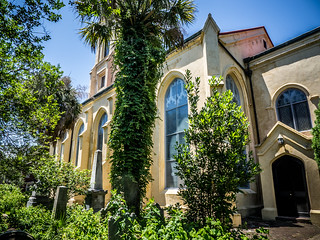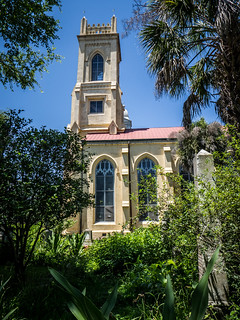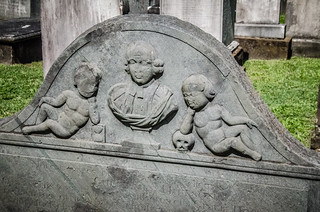Charleston has long been known as the “Holy City” because of huge number of historical churches. Since we had some time in the city after our Governor’s School reunion, I wanted to check out a few of these. Specifically, I was looking for some of the signature grave stones that I’ve spotted in historic churches all over the state. Most of these sculptors lived and worked in Charleston, so I expected to find lots of them. I was not disappointed.
Charleston Unitarian Church
Our first stop was sort of spontaneous. On our way back to the College of Charleston from the restaurant where we had our reunion Cathy Ardry suggested a shortcut through the Unitarian Church yard. The passageway connects King Street through to Philips Street, and provides a shady respite from the Charleston Heat.
What one finds at the end of that path is an incredibly overgrown graveyard.
It was nearly impossible to read some of the inscriptions because of the vegetation. There were some very old headstones, but there was no way to tell if any were the signature stones. Still, there was quite a bit of interesting artwork on the stones. I was surprised at how closely jammed together they were.
Even though it was overgrown, some of the plantings were quite nice, and the shade was a welcome relief from the city heat.
Right next to the church itself were two elaborate monuments. The most elaborate was signed by our old friend, W. T. White…
…while the other was signed by R. I. White, obviously a family member.
The church itself was an impressive structure, and looked to be in good repair. I just don’t understand why they let the churchyard go so unkempt. It did provide a interesting atmosphere.
Circular Congregation Church
After our reunion broke up, Helen Ingebritsen and her family decided to accompany Laura and me on a further exploration of churches within walking distance. Gretchen Penney had shown us another short cut, this time over to the Circular Congregation Church, where she attends. I had specifically wanted to visit this church because of its renowned collection of funerary art, including many stones by the White and Walker families.
It was a short walk over, and we found the church yard open to the public. Once again, I was amazed at how closely packed the graves were.
Many of the oldest headstones were of slate imported from New England. The predominant art form was the “Angel of Death” motif. Some of these were stylized with a skull…
…while some had a more human face.
One headstone featured a couple of cherubs – one resting on an hour glass and the other resting on a skull. These were found on either side of a bust of the departed.
As one might imagine, there were LOTS for signature stones here. There were Whites, and even one signed by a Grant from Newark, New Jersey.
A concert was scheduled for the church later in the evening, so the sanctuary was open. Helen’s husband, Tim, and I went in to take some photos of the interior and of the stained glass windows.
St. Philip’s Episcopal
I could have stayed in the church and graveyard all afternoon, but our group was ready to move on. We could see the steeple of St. Philips on the next street over. The Circular Congregation churchyard was adjacent to St. Philip’s graveyard, and we thought we could cut through. But, alas, the connecting gate was locked. We walked on around the block to the church.
The church steeple was framed beautifully against the blue sky. A crescent moon hung next to the steeple.
Where the Circular Congregation Church was open, St. Philip’s was completely locked down. The cemetery was locked up tight, as was the church itself. We had to content ourselves with looking through the fence. Once flat headstone had coins piled on it for some reason.
By this time we were really getting hot and tired. We wound down our excursion with a stop for Italian Ice, then parted ways.
While it was interesting to see so many fine examples of signature stones and artwork, it didn’t have quite the punch of finding one of these in the Upstate. One would expect to find work by the Walkers and Whites in the city where they lived and worked. However, it’s a lot more fun to come across one of these in another county, knowing that the stone had to be imported from Charleston. I’m sure if we had more time we could have seen even more examples at other churches in town. We’ll just have to save that for another trip.





































http://www.thechurchesofamerica.com/other-cities/charleston-sc-churches/
I thought you might enjoy these photos of Charleston churches.
The Unitarian church in Charleston actually has a cemetery crew of volunteers (Eden Keepers) that work monthly in the graveyard. The overgrown or “unkempt” aspect of the cemetery is intentional.
You can read more here on the church website: http://www.charlestonuu.org/GetInvolved/Activities/EdenKeepersChurchyard/tabid/132/Default.aspx
Thanks for the clarification, Pamela. That makes much more sense. The place did have a garden-like feel, but was just so different from the “perpetual care” cemeteries we see so many places.